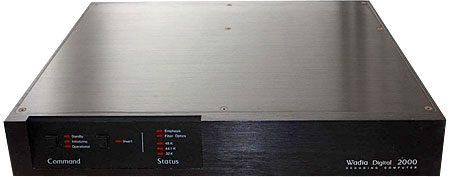| Columns Retired Columns & Blogs |
Wadia 2000 Decoding Computer
Ain't technology grand! That's what I was thinking while driving to work this morning. Sure, the rain was coming down in buckets, but there I was sitting comfortably in a warm car, listening to music while making tracks at 50mph. A long way from horse-and-buggy days.
Footnote 1: When asked "What's the best way to clean a CD?," an audiophile of the anti-digital persuasion retorted, "Sandblast it!"
Then I got to thinking about Thomas Edison and Emile Berliner. What would they think of present-day playback systems? Laser pickups, digital decoders and all. Wow! We've come a long way, baby.

Of course, some of you think otherwise (footnote 1). Digital is viewed, in the high end, as the plague that hit home music reproduction. I disagree, and I have evidence for my opinion.
If there's one thing I reaffirmed while writing this review, it's that you can't fool Mother Nature. That is, you can't break the laws of physics. Because analog is not easily quantified, it's more elusive. Consequently, more subjective judgments tend to be associated with it. Digital, on the other hand, is very quantifiable. It's a world of ones and zeros, yeses and nos. It is or it ain't. Therefore, glaring omissions are more obvious. But do you think that ever stopped anyone? Not in the least. Witness the clocking debacle of some of the very first CD players. Here they come up with a miraculous servo system to control the laser pickup, but what do they do with the clocks? They choose to generate a separate clock signal for each part of the circuitry. These uncoordinated clock frequencies produce beats. Sonic disaster!
To top it all off, when they fixed this basic design by doing what they were supposed to in the first place—using a single master clock and deriving all other clock rates from it—the manufacturers had the audacity to call it an "innovation."
We've seen many "innovations" since then, haven't we?
But let's not dwell on the past. Let's look at the digital computer in our playback systems.
Do I have anything against computers? Heck, no. I work with them every day. I see banks transfer billions of dollars from coast to coast without any errors. I see local area networks operate over twisted-pair wiring hundreds of feet long at up to 16 meg rates hour after hour.
But do you think we can transmit digital code representing music, operating at 4.3 megabits per second, over a coaxial cable 3' long? Well, we seem to have a problem here with pulse jitter, or pulse droop, and every other aspect we can use as an excuse.
I have no problems per se with computers in the playback chain. If that's what it takes, go for it! Bye bye overhang, compliance, VTF, and VTA; hello algorithm, quantization, aliasing, and dither. As we shall see later, the key word here is "algorithm." This very off-putting word is nothing ominous. In mathematics, it's nothing more than a set of instructions on how to perform a calculation.
A brave new world
Analog playback equipment has it all over digital in one respect—it flaunts the designer's vision by having everything out in the open for all to see and admire. Let's face it, the striking visual impressions of a Basis/Airtangent combo, a Versa 2.0, or a Goldmund Reference have had lasting effects on many audiophiles.
Products of this caliber are special, easily conveying how their forms follow their functions. That's not to say that every technical nuance is spelled out completely, but the idea that something very sophisticated has been executed is immediately apparent.
The sophistication of digital manifests itself differently.
Once the CD tray swallows your silver disc, you are totally machine-dependent. Digital manipulations are handled by microprocessors and integrated circuits, completely hidden from view. Processing power can never be equated with physical size or configuration. Deceptively small computer chips perform mind-boggling manipulations in a flash; it's world where a second can be an eternity.
The binary realm introduces us to new concepts and a brand-new set of buzzwords. This brave new world of ones and zeros, bits and bytes, can be intimidating. Conversely, digital comes closer to a Utopia where analysis can be effective, problems can be dissected and solved, and where engineering principles are the rule. Pulses are discrete, repeatable entities. Every stage of a process can be predicted and confirmed. It's a totally analytical situation.
But we must be careful in how we apply our newfound reliance on digital yes-no certainty. Otherwise it's déjà vu all over again! In my naïveté, I assumed that cables in the digital domain would not be a problem. Certainly not in the same manner that we know interconnects to create controversies.
Wrong! The cable from the CD transport to the processor—the only cable in the whole system carrying digital signals—can affect sound quality. I've heard it, others have confirmed it. It's there. So, do we resort to yet another endless search for the perfect cable? No! Let's get some facts together, let's analyze!
Such a statement about analog cabling would not be possible. But because digital signals can be evaluated with far greater certainty, we can consider a few facts.
Footnote 1: When asked "What's the best way to clean a CD?," an audiophile of the anti-digital persuasion retorted, "Sandblast it!"
- Log in or register to post comments




































